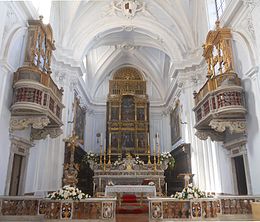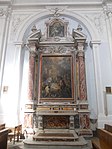Santissima Annunziata (Gaeta)
| Santuario della Santissima Annunziata, (Grotta d'Oro) |
|
|---|---|
| Patronage : | Annunciation |
Coordinates: 41 ° 12 ′ 43.1 ″ N , 13 ° 34 ′ 52.8 ″ E
The Santissima Annunziata of Gaeta is an important church and sanctuary (Italian: Santuario ) in the coastal town of Gaeta between Rome and Naples . It is located directly on the sea, on the promenade (Lungomare Giovanni Caboto) of Gaeta. It got its name and its patronage after the Annunciation , in Italian : Santissima Annunziata .
The complex once also included a hospital and an orphanage . The so-called "golden grotto" ( Grotta d'oro ) or "golden chapel" is famous .
history
The church was founded in 1320 at the request of the University of Gaeta and subsequently built outside the city walls, it was consecrated in 1352.
In 1355, following the construction of the church, a hospital was founded, which was enlarged again and again in the following centuries and of which the large hospital ward with a barrel vault from the 16th century has been preserved. The pharmacy belonging to the building complex was one of the most important in the Kingdom of Naples in the 17th century .
In 1536 the church building was partially destroyed and changed to make way for the city's bastions , which were built under Charles V but no longer exist today.
From 1621 a comprehensive renovation took place in the spirit of the Neapolitan Baroque , in which the architect Andrea Lazzari and his son Dionisio Lazzari were involved.
In March 2009 the church was promoted to sanctuary.
The Chiesa dell'Annunziata has a valuable music library with dozens of handwritten codices adorned with valuable miniatures .
description
The baroque facade of the church comes from Andrea Lazzari. It is supported by pilasters with Corinthian (basement) and composite - capitals divided (upstairs). The stucco decoration consists of festoons and winged angel heads ( cherubim , seraphim ) over the portal, windows and niches on the upper floor. The top is a clock decorated with Maiolica tiles by Matteo De Vivo and a bell tower ("campanile a vela") , which were only added at the beginning of the 18th century.
The interior consists of a single, narrow and high nave , which in its emphatically vertical orientation and with its ribbed vault still shows clear traces of the original Gothic architecture despite the elegant baroque decoration . The walls, however, are kept entirely in the style of the 17th century, with fluted Ionic pilasters , wide rectangular windows in the upper wall area and baroque stucco ornaments, again below winged heads of seraphim or cherubim. On the sides of the nave are two large baroque altars, the colored marble décor of which was designed by Dionisio Lazzari. The altarpieces of the Crucifixion and the Adoration of the Shepherds were painted by Luca Giordano in 1690. In the current Cappella del Santissimo Sacramento you can see a Madonna and Child by Giacinto Brandi (1660).
The decoration of the choir is also largely due to Dionisio Lazzari, including the marble altar with ornate Pietra dura inlays in the form of floral motifs and arabesques. The richly carved walnut choir stalls date from the 16th century. The two paintings on the side walls of the apse were created by Sebastiano Conca in 1720: They show the presentation of Jesus in the temple and the adoration of the kings . The high altar in the apse consists of a magnificent gilded polyptych from the 16th century that came to the church as a gift from a certain Giuliano Colojna, a citizen of Gaeta. The paintings were created by Giovan Filippo Criscuolo from the school of Andrea da Salerno in 1521; depicted are: Death and Resurrection of Christ , the Annunciation and the Saints John the Baptist , Jerome , Ambrose and Peter . Above the high altar is a gilded, richly ornamented lattice, behind which the “orphan's choir” (Coro delle orfanelle) is located, where nuns and orphans took part in the masses , protected from prying eyes .
Cherub on the tabernacle of the main altar
The baroque organ
On both sides of the presbytery there are two organs (1674–1677), which were also designed by Dionisio Lazzari and were originally supposed to be made of marble, but were made of wood due to financial constraints. The organ on the left gallery was built by the organ builder of the Royal Chapel of Naples Giuseppe De Martino between 1685 and 1689; it is the oldest surviving instrument of this important organ builder , on which Alessandro Scarlatti (1660–1725) is said to have also played. The original disposition consisted of 7 registers ( Principale 8 ′ , Ottava , XV , XIX , XXII , XXVI , XXIX ), in 1859 a contrabbassi was installed. The keyboard has 48 keys and is completely chromatic - a rarity at the time it was created - but without the deep C #.
The organ was in the orphan's choir from 1927 (above and behind the high altar) and was completely forgotten until 1980 and in urgent need of restoration . Only research by Graziano Fronzuto brought the above information about the instrument and its builder to light and led to the historical installation on the left gallery.
The golden grotto
The Cappella or Grotta d'Oro (actually: Cappella dell'Immacolata ) has its own entrance on Via Annunziata with a marble portal by Dionisio Lazzari. The name refers to the rich gilding (on a blue background) of the wood-carved, coffered vault. The chapel opens on the 14th-15th Century and was furnished in the 16th century by Criscuolo and some of his students with an 18-part painting cycle. The Maria Immaculata (or Assumption of Mary ) on the altar is a work by Scipione Pulzone from 1582.
Pope Pius IX came regularly to pray in the Grotta d'Oro during a stay in Gaeta in 1848/49 . One of these prayers on December 8, 1848 before the Immaculate of Pulzone is said to have inspired him to adopt the dogma of the Immaculate Conception of Mary (1854). Later, John Paul II also visited the chapel to pray in it.
literature
- Paolo Capobianco: Gaeta città di Maria: la cappella dell'Immacolata o Grotta d'oro nella chiesa della SS. Annunziata di Gaeta. edizione II, 1989.
- Graziano Fronzuto: "Chiesa della SS. Annunziata di Gaeta" , article about church and organ on the "Pagina dell'Organo" (Italian; seen on April 4, 2019; also source of this article)
- Graziano Fronzuto (ed.): L'Istituto e la Chiesa della SS. Annunziata di Gaeta: breve guida attraverso la storia e l'arte, Provincia di Latina. May 1997.
- Graziano Fronzuto: L'organo del 17 ° secolo della chiesa della SS.ma Annunziata in Gaeta. In: Informazione organistica. n. 1-2, 1994.
- Graziano Fronzuto: Monumenti d'arte sacra a Gaeta: storia ed arte dei maggiori edifici religiosi di Gaeta. Edizioni del Comune di Gaeta, Gaeta, 2001.
- Beatrice Locci (Ed.): Il complesso monumentale della SS. Annunziata di Gaeta. Graficart, Formia, 2012. ISBN 88-89021-60-8
Web links
- The “Santissima Annunziata” by Gaeta on “cattedralegaeta.it” , viewed on April 4, 2019 (Italian; source for this article)
- Website of the municipality (Italian)
- The "Santissima Annunziata" by Gaeta on "prolocogaeta.it" , viewed on April 4, 2019 (Italian; source for this article)
- The Church of Santissima Annunziata of Gaeta on southlazioitaly.com , viewed April 4, 2019
- The "Santissima Annunziata" from Gaeta on "tripadvisor" , seen on April 4, 2019 (Italian)
- "Santuario della Santissima Annunziata" by Gaeta on "findglocal.com" , seen on April 4, 2019 (Italian)
- "Chiesa della Santissima Annunziata" by Gaeta on "Facebook" , seen on April 4, 2019 (Italian)
Individual evidence
- ↑ a b c d e f g h i The "Santuario della Santissima Annunziata" by Gaeta on "prolocogaeta.it" , viewed on April 4, 2019 (Italian)
- ↑ a b "Church of Santissima Annunziata of Gaeta" on "southlazioitaly.com" , seen on April 4, 2019 (English; pictures!)
- ↑ "Santuario della Santissima Annunziata" by Gaeta on "findglocal.com" , viewed on April 4, 2019 (Italian)
- ↑ a b c d e f g h i j k l m n o p q The "Santissima Annunziata" by Gaeta on "cattedralegaeta.it" , viewed on April 4, 2019 (Italian)
- ↑ a b c d e f g h i Graziano Fronzuto: "Chiesa della SS. Annunziata di Gaeta" , article on the church and organ on the "Pagina dell'Organo" (Italian; viewed on April 4, 2019)










